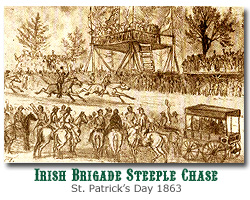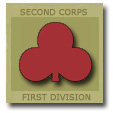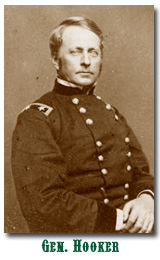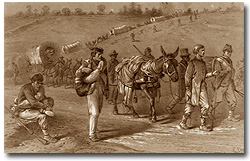1861
| 1862 | 1864 |
1865
Regimental
History: 1863
 en.
Burnside, pressured to resume the offensive against his foes across the
Rappahannock, roused the Army of the Potomac out of its camps at
Falmouth on January 23 and set in motion in what turned out to be known
as the infamous "Mud March."
en.
Burnside, pressured to resume the offensive against his foes across the
Rappahannock, roused the Army of the Potomac out of its camps at
Falmouth on January 23 and set in motion in what turned out to be known
as the infamous "Mud March."
As the army moved out, storm clouds
unleashed relentless rain that quickly reduced the poor country roads
into quagmires. The 28th Massachusetts, like much of the 2nd Corps, was
fortunate to be spared the worst of the march owing to its fortuitous
position at the end of the line. For the balance of the winter, the
Irishmen remained in camp, refitting for a new campaign in the spring.
 In spite of the grievous losses suffered
by the Irish Brigade over the preceding months, the men fully lived up
to their traditions with a boisterous, rollicking celebration of St.
Patrick's Day. The feature event was Grand Irish Steeple Chase in which
horses ridden by brigade and regimental officers competed for a $500
purse. The race attracted the attention of the entire army as well as
the many newspaper correspondents traveling with it.
In spite of the grievous losses suffered
by the Irish Brigade over the preceding months, the men fully lived up
to their traditions with a boisterous, rollicking celebration of St.
Patrick's Day. The feature event was Grand Irish Steeple Chase in which
horses ridden by brigade and regimental officers competed for a $500
purse. The race attracted the attention of the entire army as well as
the many newspaper correspondents traveling with it.
Col. St. Clair Mulholland
of the 116th
Pennsylvania recalled later: "St. Patrick's Day in camp was celebrated
with the usual gayety and rejoicing by the men composing the Irish
Brigade. This time-honored national anniversary was observed with all
the exhaustless spirit and enthusiasm of Irish nature."
Around this time, the men
of the 28th
Massachusetts were ordered to wear a new corps badge - a red trefoil -
along with the rest of the First Division. At around the same time, the
newly promoted Lt. Col. George Cartwright rejoined the unit after
recovering from the wounds he suffered at 2nd Bull Run.
 On April 6, four 2nd lieutenants arrived
in camp to accept commissions in the regiment for positions left open
by past battle casualties. The new officers all came from other
Massachusetts volunteer regiments rather than from the 28th. Col.
Byrnes, having previously found only three of his own non-commissioned
officers worthy of commissions, had relied on the adjutant general of
Massachusetts to help locate other deserving candidates.
On April 6, four 2nd lieutenants arrived
in camp to accept commissions in the regiment for positions left open
by past battle casualties. The new officers all came from other
Massachusetts volunteer regiments rather than from the 28th. Col.
Byrnes, having previously found only three of his own non-commissioned
officers worthy of commissions, had relied on the adjutant general of
Massachusetts to help locate other deserving candidates.
Yet again, there was uproar in the ranks,
and some of the other officers even presented their commander a
petition of protest in front of the entire regiment. This was too much
for Byrnes, whose response was swift and predictable. He immediately
had the three captains he suspected of being the ringleaders - Charles
Sanborn of Co. K, John H. McDonnel of Co. H, and Jeremiah Coveney of
Co. F - brought up on charges of "mutinous and seditious conduct" and
sought to have them court martialed.
The regiment marched from camp at Falmouth
with the rest of the Irish Brigade on April 27 to begin the spring
campaign, leaving Byrnes no choice to order his subordinates released
so they could take charge of their companies. According to Sgt. Peter
Welsh of Co. K: "When they came to take command we gave them three
rousing cheers and that made him (Byrnes) so mad that he ordered
them… under arrest again."
In the end, the captains were sentenced to
public reprimands for lesser charges, but the damage had been done. By
then, three captains, five 1st lieutenants, and two 2nd lieutenants had
resigned from the regiment, many apparently out of displeasure with
Byrnes. These internal problems aside, the regiment was in fact shaping
up into a model unit. In a report, Maj. Gen. Winfield Hancock,
commanding the 2nd Corps, complimented Byrnes for his "fine,
disciplined regiment."
 Under the new overall commander of the
Union army, Maj. Gen. Joseph Hooker of Massachusetts, the 28th saw
action in the late April campaign that ended in the debacle at
Chancellorsville. Along with the Irish Brigade, the regiment marched
across the Rapidan River in support of the federal advance, but ended
up playing a largely defensive role in the battle.
Under the new overall commander of the
Union army, Maj. Gen. Joseph Hooker of Massachusetts, the 28th saw
action in the late April campaign that ended in the debacle at
Chancellorsville. Along with the Irish Brigade, the regiment marched
across the Rapidan River in support of the federal advance, but ended
up playing a largely defensive role in the battle.
Between April 27 and 29, the Irish regiments guarded the roads that led
crossings of the Rappahannock River. They remained at their posts until
they were called up to join the main body of the army on April 30, but
remained at the rear, helping stem the tide of retreating 11th Corps
soldiers on May 2.
Early the next morning, Confederate troops
resumed their attacks on the fortified Union lines, which had begun to
withdraw. Amidst the confusion, the Irish Brigade was posted at the
edge of woods near the Chancellor house clearing. Just as the federals
were getting re-organized to the rear, there was a strong rebel advance
on the exposed 5th Maine Battery, which was located nearby, most of its
crews and horses killed or wounded.
With the guns facing imminent capture, a
detail of men from the 28th Massachusetts and 116th Pennsylvania was
called upon to rush in and help withdraw them. Unfortunately, the guns
were stuck in mud. Only with great effort and after losing a number of
men were the Irish able to save the Maine artillery pieces.
For the remainder of the day, the 28th
Massachusetts occupied a position along the breastworks in the center
of the Union line, fending off Confederate sniper fire and awaiting
another attack that never came. The regiment suffered 26 casualties
before withdrawing on the night of May 5 and re-crossing the Rapidan
River the next morning.
Returning to camp at Falmouth, the 28th
settled in to await further orders. During this time, Byrnes took pains
to make sure that every man in his regiment was well outfitted, with
good shoes and necessary clothing. He also insisted on plenty of drill
and began requiring his men to take regular target practice, at least
in part because the 28th Massachusetts was the only unit in the Irish
Brigade equipped with rifled muskets.
The only significant break in the monotony
came on May 7, when President Lincoln came for a morale-lifting visit
with his troops. The men of the Irish Brigade caught glimpses of their
president as they marched by in review with the rest of the army.
 On May 14, Brig. Gen. Meagher informed
the soldiers of the Irish Brigade that he was resigning as their
commander. Since February, he had been seeking to take his three
undermanned New York regiments home, where they could recruit back up
to strength and enjoy a much-deserved furlough. Rebuffed repeatedly, he
finally chose to resign rather than remain in command of a brigade that
was only a skeleton of its former self.
On May 14, Brig. Gen. Meagher informed
the soldiers of the Irish Brigade that he was resigning as their
commander. Since February, he had been seeking to take his three
undermanned New York regiments home, where they could recruit back up
to strength and enjoy a much-deserved furlough. Rebuffed repeatedly, he
finally chose to resign rather than remain in command of a brigade that
was only a skeleton of its former self.
Col. James Kelly of the 88th New York, as
the senior regimental officer, succeeded Meagher as commander of the
Irish Brigade. The departing Meagher described Kelly, a veteran of all
the brigade's battles since Seven Pines, as "a true, conscientious,
unwearied, uncomplaining, indomitable, absolutely fearless soldier."
At last, on June 13, the 28th Massachusetts
was ordered out of camp. The regiment marched to the banks of the
Rappahannock and on the next day continued to Stafford Courthouse. This
would be the first of a long and arduous series of forced marches that
were a part of Hooker's strategy to ward off Lee's second invasion of
the North. Anticipating many more days like this one, Byrnes ordered
that officers be positioned at the head and tail of each company at all
times to prevent straggling.
 In summer heat and suffocating dust from
dry roads, the 28th marched northward over the next two weeks through
Fairfax Station, Centerville and Thoroughfare Gap before crossing the
Potomac River at Edward's Ferry and heading through Frederick,
Maryland. On June 29 - the day after command of the federal army was
transferred from Hooker to Gen. George Meade - the Irish Brigade
marched a grueling 32 miles to Uniontown, although many of its men fell
off to the side of the road, prostrate from the heat. Sgt. Peter Welsh
of the 28th wrote that only 40 of his regiment's 225 men in were
present with the colors at the end of this exhausting march.
In summer heat and suffocating dust from
dry roads, the 28th marched northward over the next two weeks through
Fairfax Station, Centerville and Thoroughfare Gap before crossing the
Potomac River at Edward's Ferry and heading through Frederick,
Maryland. On June 29 - the day after command of the federal army was
transferred from Hooker to Gen. George Meade - the Irish Brigade
marched a grueling 32 miles to Uniontown, although many of its men fell
off to the side of the road, prostrate from the heat. Sgt. Peter Welsh
of the 28th wrote that only 40 of his regiment's 225 men in were
present with the colors at the end of this exhausting march.
Continued
>

